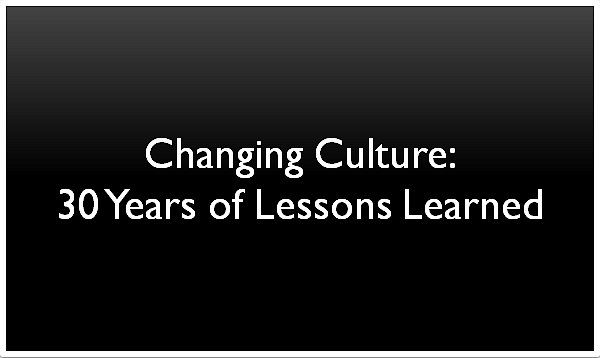Where to Next for the CHRO & Culture? 5 Things Every CHRO Should be Doing in 2018
5 Things Every CHRO Should be Doing in 2018
1) Re-Enroll Top Leaders in Their Role as Culture Architects
Another way to say this is: raise the bar. Some CEOs and their executive teams are already immersed in understanding their culture and intentionally shaping it based on a shared vision of the future culture needed for success.
Many, however, are saying that while top leaders pay attention to some aspects of culture (Compliance, Safety or Engagement), their perspective of the culture isn’t complete. It’s more like seeing parts of an airplane without understanding if the plane is ready to take-off and land in a new location. Most executives are ready for new approaches to developing culture and HR needs to be in the game.
In 2018, CHROs need to re-enroll CEOs and their executive teams in culture development. You need to ask:
- Is the executive team acting as culture architects, cohesively focusing on what needs to be different in the culture?
- Are they clear about culture priorities, opportunities, and risks?
- What are they doing about these priorities, opportunities, and risks?
- Do their own behaviors embody company values or are they inconsistent?
- Are they in this together, shaping culture for the future, or are some members opting out, clinging to outdated behaviors and practices?
Now is the time to have these conversations with the executive team, so they can raise the bar on their role as culture architects.
2) Take the Long View
Culture development is a journey that requires CHRO’s to continuously help the organization build its culture story and develop new kinds of culture muscle to meet long-term needs. It takes time, so CHROs need to be patient, persistent, and ready for intense periods of dialogue and learning. Kathleen Hogan, CHRO at Microsoft, has been part of its culture change. She says, “I also can’t over-emphasize the significance of perspective over time. It’s a journey that requires endurance, belief, and optimism for the future.”
Taking the long view means:
- Creating Meaning – understanding what is happening inside and outside your company that requires change. This means connecting the dots between Mission, Strategy, Brand, Leadership, and Culture. It also means making sure communications and dialogue improve understanding of the desired future culture and how this connects everyone to Purpose and Strategy.
- Activating – building desire and accountability for developing the future-state culture and making sure company leaders own culture change, not just HR. HR owns some of the levers for culture change and should, of course, continuously align these to the desired future state. Indeed, in 2018 CHROs should be critically examining the organizational design and people systems to spot where traditional approaches are just not cutting it. Activating requires enrolling every leader and team in strengthening the culture muscles needed for the challenges ahead.
- Learning and Iterating – when the future-state culture is defined and desired behaviors become clear, the time is right to experiment with new ways of working together. HR can play a key role in supporting pilots, gathering anecdotal evidence of culture change, and identifying systemic barriers. An important part of this is making sure leaders are supported as they learn. Leaders may want to go outside to find out more about agility or innovation or bring their teams together to develop culture action strategies. They may reach out for executive coaching or need support for team development. The CHRO needs to lobby the CEO to make sure that resources are available to support culture change.
3) Keep Holding Mirrors Up
Given the leader behavior scandals of 2017, CEOs and Boards will be asking more questions about how to understand company culture and its risks. CHROs need to make sure they have a robust culture measurement system that can feed meaningful data to leaders for action. HR already has access to some terrific data and, when combined with other data points, insights can be unlocked about underlying beliefs, assumptions, norms of behavior, and practices that support success or create risk.
To do this, the CHRO needs to develop a plan to frequently bring key data to the executive team to unpack the story of the culture, its dynamics, risks, and opportunities. Next, the CHRO needs to persist in seeding data into the executive agenda. This may mean partnering with other departments such as Marketing, Safety, or Quality. These groups also have measures that reflect culture. Frequent snapshots of where progress toward the desired culture is being seen and where it has stalled will help top leaders understand the culture, what needs attention, and where they can intervene. Finally, the CHRO needs to present all of the data from a future-focus perspective. This will help top leaders understand the implications for the delivery of strategic imperatives.
Consider the following as part of a robust culture measurement system:
- Quantitative – statistical, trending
- Engagement survey – a targeted survey to understand employee loyalty
- Diversity and inclusion
- Customer service issues, trends, and risks
- Safety trends, issues, and risks
- Compliance trends, issues, and risks
- Qualitative – diagnostic, priority setting
- Culture survey – a broad and deep culture measurement to understand overall culture strengths, development needs, dynamics, and vulnerabilities
- Culture pulse – frequent checks on the employee experience
- Leadership assessments – the strength of leadership capability to build a strong foundation, culture, and teams
- Observation – emergent, potential to learn and migrate successes
- Story gathering and analysis – changes to practices, behaviors, and beliefs that reflect the future-state culture and get results needed for strategy. It’s beneficial to look more and post change to assess whether culture change is being sustained
- Anecdotes – seminal events unpacked, project or initiative post-mortems/retrospectives
4) Focus on What is Experienced
While focusing on engagement helps leaders understand employee loyalty and perceptions of the company, it is what employees, customers, suppliers, and contract/contingent workers are experiencing that reveals how healthy the foundation culture is and how the journey to the future culture is progressing.
No “fast growth” company like Uber should be shocked to learn that a toxic culture is being experienced by staff and contractors. No large company with hundreds or thousands of contingent workers should discover in the press that its culture holds back the innovation pipeline or damages the customer experience. No organization should be surprised to be called out in #MeToo postings.
The CHRO in 2018 should be on a campaign to ‘Know Our Culture’ from different perspectives. These include:
- Top leaders – where misalignment to values is so damaging to reputation and culture development
- Talent – those under contract such as in Media, Entertainment
- Employees – by groups and demographics
- Contractor and contingent workers – how they experience the culture, how it influences their beliefs and behaviors
This is a tall order but can be staged as quarterly, annual, or every second-year processes. For example, one animation company surveys its employees with a broad and deep culture survey every second year and with quarterly Culture Pulses. Their Talent gets their own custom survey annually. These provide deep insights for building unique competitive culture DNA that attracts the best Talent and performers in the industry.
5) Keep the Board Apprised
Given the toppling of so many leaders in Media, Entertainment and Politics at the end of 2017, the Board will likely ask the CEO and CHRO how they will be stewarding culture and managing its risk in 2018. An annual presentation of Engagement Survey results or summary of the Compliance Audit is unlikely to be sufficient to build confidence that culture risk is being managed.
Wise CHROs should consider how to help the Board understand the organization’s unique culture DNA, its strengths to be leveraged, and priority areas for attention. With the CEO, they need to talk to the Board about how culture is being developed and prepare them for hard choices ahead: organizational redesign, removal of culture violators, shifts in managing systems etc..
In 2018, the CHRO has a huge role to play in culture development. The need for firefighting will not go away and neither will the need to upgrade HR processes and systems. Nevertheless, in 2018, CHROs need to carve out more time for culture, helping leaders and stakeholders understand the way it operates, building the future culture story, activating everyone, and then supporting learning and iteration.
Culture-Strategy Fit shares its knowledge and tools through the Culture Resource Center, a hub of culture activities, tools and surveys to support organizations intent on shaping culture fit to strategy. Sherrill Burns, the Co-Founder, writes frequently about how to leverage culture for competitive success.












